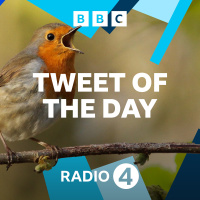Sinopsis
Discover birds through their songs and calls. Each Tweet of the Day begins with a call or song, followed by a story of fascinating ornithology inspired by the sound.
Episodios
-
Greater Roadrunner
22/01/2015 Duración: 01minMichael Palin presents the greater roadrunner of south western North America. A cuckoo that can run at 20 miles per hour and snap up venomous reptiles might not seem destined for cartoon fame, but that's exactly what happened to the Greater Roadrunner.The loud "beep-beep" call of the Warner Brothers cartoon creation, always out-foxing his arch-enemy Wile-E. Coyote brought this very odd member of the cuckoo family racing into the living rooms of the western world from 1949 onwards . Greater roadrunners live in dry sunny places in the south western states of North America, where their long-tailed, bushy--crested, streaky forms are a common sight. They will eat almost anything from scorpions to rats, outrunning small rodents and lizards and even leaping into the air to catch flying insects. As it runs across the desert, the roadrunner's footprints show two toes pointing forward and two backwards. The "X" shape this forms was considered a sacred symbol by Pueblo tribes and believed to confound evil spirits bec
-
Horned Screamer
21/01/2015 Duración: 01minMichael Palin presents the Venezuelan horned screamer. Soundling as if someone is using a giant plunger in the Venezuelan marshes, these are the mating calls of the Horned Screamer. They're sounds that only another Horned Screamer could love, but then screamers are very odd birds. Over the years ornithologists have struggled to classify them, modern thinking puts their closest living relatives as the primitive Australian Magpie Goose.Protruding from its head is a long wiry horn made of cartilage, which could rightfully earn it the title of "unicorn of the bird world" Usually seen as pairs or, outside the breeding season in small groups in the marshes and savannas of the northern half of South America, as you'd expect from their name , they are very vocal and these primeval bellows which sound more cow like than bird like and can be heard up to 3 kilometers away.Producer : Andrew Dawes
-
Kakapo
20/01/2015 Duración: 01minMichael Palin presents the New Zealand Kakapo, high on the ferny slopes of its island fortress off the coast of New Zealand. Kakapos are flightless and the heaviest parrots in the world. They're also called owl-parrots from their nocturnal habits and open owlish expressions. Like owls their plumage is richly mottled although no owl shares their beautiful moss-green tones. Kakapos also have a curious mating strategy. The males gather at traditional "leks" or display areas to attract mates. At the top of a wooded ridge, the male digs one or more a bowl- like depressions in the ground which function as an amplifier. He then takes a deep breath, swells his throat-pouch like a balloon then releases the air with a soft booming call which can carry up to five kilometres. This sound can now only be heard on a handful of offshore islands. The kakapo story is tragically familiar. Flightless and ground-nesting, it was helpless in the face of settlers who logged its forests and introduced cats and rats which slaughte
-
Harpy Eagle
19/01/2015 Duración: 01minMichael Palin presents the harpy eagle flying over the Brazilian rainforest. This is one of the most powerful birds of prey and links mythological corpse-bearers, the coat of arms of Panama and the Harry Potter films. In Greek mythology harpies were creatures with the bodies of eagles and the faces of women, who seized people in their claws. A human body is beyond the real-life harpy eagle, but with its massive 12 cm talons, it can carry a full-grown sloth or an adult howler monkey. Being versatile hunters, the eagles catch a range of birds and reptiles and can easily hoist porcupines and armadillos into the treetops to feed their young.Harpy Eagles breed in the rainforests of central and South America. They're blackish- grey above and white below with a black collar and a divided crest which gives them an uncanny resemblance to Buckbeak the Hippogriff in 'Harry Potter and the Prisoner of Azkaban'. Producer : Andrew Dawes
-
Sulphur-crested Cockatoo
16/01/2015 Duración: 01minTweet of the Day is the voice of birds and our relationship with them, from around the world.Liz Bonnin presents the raucous calling sulphur-crested cockatoo from Australia. It is with somewhat heavy irony that with its loud, jarring calls, the sulphur crested cockatoo is also known as the "Australian Nightingale". These large white parrots with their formidable curved beaks and long yellow crests which they fan out when excited are familiar aviary birds. One of the reasons that they're popular as cage birds is that they can mimic the human voice and can live to a great age. A bird known as Cocky Bennett from Sydney lived until he was a hundred years old, although by the time he died in the early 1900s he was completely bald, and was then stuffed for posterity. In its native forests of Australia and New Guinea, those far-carrying calls are perfect for keeping cockatoo flocks together. They're highly intelligent birds and when they feed, at least one will act as a sentinel ready to sound the alarm in case of d
-
Trumpeter Swan
15/01/2015 Duración: 01minTweet of the Day is the voice of birds and our relationship with them, from around the world. Liz Bonnin presents the sonorous trumpeter swan of North America. Across an Alaskan wilderness powerful sounds and calls emanate from the largest and heaviest of all wildfowl, the pure white trumpeter swan. With a wingspan of up to 250 cm, the biggest male trumpeter swan on record weighed over 17 kilogrammes, heavier than mute swans. They breed on shallow ponds and lakes in the wilder parts of north west and central North America. Hunted for feathers and skins, they were once one of the most threatened birds on the continent, with only 69 birds known in the United States, although populations hung on in Alaska and Canada. Since then trumpeters have been protected by law and populations have recovered in many areas. Alaska and Canada remain strongholds and today reintroductions are returning this musical bird to their former range in the USA.
-
Adelie Penguin
14/01/2015 Duración: 01minTweet of the Day is the voice of birds and our relationship with them, from around the world. Liz Bonnin presents the adelie penguin on a windswept Antarctic shore. A huddle of braying shapes on a windswept shore in Antarctica reveals itself to be a rookery of Adelie Penguins. These medium sized penguins whose white eye-ring gives them an expression of permanent astonishment were discovered in 1840 and named after the land which French explorer Jules Dumont d'-Urville named in honour of his wife Adele. They make a rudimentary nest of pebbles (sometimes pinched from a neighbour) from which their eggs hatch on ice-free shores in December, Antarctica's warmest month, when temperatures reach a sizzling minus two degrees. In March the adult penguins follow the growing pack ice north as it forms, feeding at its edge on a rich diet of krill, small fish and crustaceans. But as climate change raises ocean temperatures, the ice edge forms further south nearer to some of the breeding colonies, reducing the distance
-
Black-footed Albatross
13/01/2015 Duración: 01minTweet of the Day is the voice of birds and our relationship with them, from around the world. Liz Bonnin presents the black-footed albatross of Midway Atoll in the Pacific Ocean. Two dusky-brown birds point their bills skywards to cement their lifelong relationship, these are black-footed albatrosses are plighting their troth in a former theatre of war. At only a few square kilometres in size, the island of Midway is roughly half way between North America and Japan. Once it was at the heart of the Battle of Midway during World War Two, but today it forms part of a Wildlife Refuge run by the U.S. Fish and Wildlife Service and is home to white laysan albatross and the darker Black footed Albatross. Around 25,000 pairs of Black-foots breed here. Each pair's single chick is fed on regurgitated offal for six months, after which it learns to fly and then can be vulnerable to human activity on the airbase. But careful management of both species of albatrosses near the airstrip has reduced the number of casualtie
-
Snow Petrel
12/01/2015 Duración: 01minTweet of the Day is the voice of birds and our relationship with them, from around the world. Liz Bonnin presents an Antarctic specialist, the delicate looking snow petrel. On a wind blasted Antarctic iceberg, small white hummocks sprout beaks to bicker and flirt with each other. These are snow petrels, one of the hardiest bird species in the world. Few bird species breed in the Antarctic and fewer still are so intimately bound to the landscape of snow and ice. But the near pure white snow petrel makes its home in places where temperatures can plummet to -40 Celsius and below. Returning to their breeding areas from October, the nest is a skimpy affair nothing more than a pebble-lined scrape in a hollow or rocky crevice where the parents rear their single chick on a diet of waxy stomach oil and carrion. But for a bird of such purity the snow petrel has a ghoulish diet, foraging at whale and seal carcasses along the shore. Although it breeds on islands such as South Georgia which are north of the summer pa
-
Montserrat Oriole
09/01/2015 Duración: 01minTweet of the Day is the voice of birds and our relationship with them, from around the world.Liz Bonnin presents Montserrat oriole from the Caribbean island of Montserrat. In 1995, after being dormant for over 300 years, a volcano on erupted. The eruption not only destroyed Montserrat's capital but much of the wildlife couldn't escape, and one bird, the Montserrat oriole was almost silenced forever. The male is a colourful bird with coal-black head, wings and tail and underparts the colour of egg-yolk. It is one of the most endangered birds in the world, a bird caught between a rock and a hard place. Its forest home had already been reduced by cultivation and introduced predators. It was reduced to living in fragmented pockets of forest, two thirds of which were destroyed in the 1995 and later eruptions. This threatened to wipe out an already endangered bird. So, conservationists from Jersey Zoo moved 8 orioles into captivity to avoid natural extinction and now a captive breeding programme is successfully und
-
Brown Skua
08/01/2015 Duración: 01minTweet of the Day is the voice of birds and our relationship with them, from around the world. Liz Bonnin presents brown skua hunting over an Antarctic landscape. These bulky brown birds with their hooked death dealing bills are often cast as villains alongside the apparently helpless and lovable penguins. But skuas are highly efficient predators, their skills honed to find the maximum food they can in a largely barren landscape. They're resourceful pirates, forcing other birds to drop or disgorge their catches. They also scavenge around fishing boats or loiter at seal colonies where carcases are easy meat. But a penguin rookery which may have hundreds of pairs of birds provides a real bounty, where waiting for an opportunity, the keen-eyed skua swoops to seize its next victim which if it is small enough, will even swallow it whole.Producer : Andrew Dawes
-
Blue Rock Thrush
07/01/2015 Duración: 01minTweet of the Day is the voice of birds and our relationship with them, from around the world.Liz Bonnin presents the blue rock thrush, perched high on a Spanish castle. The blue rock thrush has a slim silhouette, rather like that of a blackbird, but these largely sedentary, elusive and sun-loving birds are a rare sight in northern Europe. They are widespread in summer across southern Europe and also occur in the Arabian Peninsula and across most of south-east Asia. The male lives up to his name, as in sunlight his deep indigo body feathers contrast with his darker wings and tail. His mate is a more muted mid brown, and barred beneath. Blue rock thrushes often nest in old ruins, but can also be found in houses in villages and on the edge of towns. Here in sunny spots they feed on large insects like grasshoppers and will even take small reptiles in their long thrush-like bills.Producer Andrew Dawes.
-
Spoon-billed Sandpiper
06/01/2015 Duración: 01minTweet of the Day is the voice of birds and our relationship with them, from around the world. Liz Bonnin presents the diminutive spoon-billed sandpiper of the high Russian tundra. Spoon-billed sandpipers are wading birds, no bigger than a house sparrow. They have rust-coloured feathers and a black, spoon-shaped bill for sifting tiny creatures from the mud or catching insects on the tundra of eastern Russia, where they breed. In winter they fly down to south-east Asian estuaries. Here they are increasingly threatened by the reclamation of mudflats for development and by local people who trap the waders in fine nests to eat. Today, there may be fewer than a thousand birds left. Now conservationists have taken some birds into captivity to establish a breeding stock, but others are being helped on their breeding grounds by headstarting, whereby adults are encouraged to lay a second clutch of eggs after the first are removed. Its hope that this work, plus encouraging local hunters in Asia to release any sandpipers
-
Raggiana Bird-of-Paradise
05/01/2015 Duración: 01minTweet of the Day is the voice of birds and our relationship with them, from around the world. Liz Bonnin presents the displaying Raggiana bird-of-paradise from Papua New Guinea. An explosion of colour flashes across the tree canopy of a rainforest: male Raggiana birds-of-paradise, one of the most spectacularly coloured birds in the world, are displaying to one another. The Raggiana or Count Raggi's bird-of-paradise is Papua New Guinea's national bird and it's easy to see why. His yellow head and green throat are eye-catching enough but even more flamboyant are the long tufted flank feathers which he can raise into a fan of fine reddish-orange plumes. Males gather at traditional display sites quivering these enormous flaming plumes like cabaret dancers as they cling to an advantageous branch. The urgency of their display is underlined by frantic calls which echo through the canopy, in the hope he can impress the much plainer female to mate with him.Producer : Andrew Dawes
-
Black Swan
02/01/2015 Duración: 01minTweet of the Day is the voice of birds and our relationship with them, from around the world. Sir David Attenborough presents a widely regarded symbol of Australia, the black swan. These stately looking birds are native to the wetlands of south-western and eastern Australia. The New Zealand population was hunted to extinction but has now been reintroduced there. Their plumage is charcoal grey rather than black and beautifully ruched along their lower back, hiding the white primary feathers which are fully revealed in flight. Their only colour is a raspberry- coloured bill. Black swans behave like nomads, tracking local rains and breeding when they can. In Britain as a collection bird, a few have even cross-bred with mute swans to produce a greyish hybrid nick-named the 'Blute Swan'.
-
White Tern
01/01/2015 Duración: 01minTweet of the Day is the voice of birds and our relationship with them, from around the world. Sir David Attenborough presents the widespread marine species, the white tern. Also known as fairy terns or angel terns, these are very slender, long-winged birds, brilliant white except for a black, slightly-upturned bill, dark eyes and very short blue-grey legs. In flight, their wings appear almost translucent. For such a delicate-looking bird, they have rather harsh calls. Unusually they lay their eggs on a bare branch. The female tern selects a small groove in the bark or on the leaf-stalks of palms where her single egg will be most secure. Here, on its tropical tightrope, the egg is safer from ground predators like rats and because there's no nesting material, there's less chance of parasites.Producer : Andrew Dawes
-
Greater Hill Mynah
31/12/2014 Duración: 01minTweet of the Day is the voice of birds and our relationship with them, from around the world. Sir David Attenborough presents the mimic specialist Greater Hill Mynah from Asia. Like many members of the starling family, Greater Hill Mynah's are superb mimics with a remarkable ability to reproduce the tones of the human voice. This makes them popular as cage and now some wild populations have been severely reduced by collecting. Hill mynahs are not just vocally outstanding. They're dapper looking birds too; glossy purplish-black with a white wing-patch and wattles of bright yellow skin under their eyes and around the back of their necks. The wild birds don't impersonate people though; it's only those captive birds which are amongst some of the best mimics of the human voice.
-
Laughing Kookaburra
30/12/2014 Duración: 01minTweet of the Day is the voice of birds and our relationship with them, from around the world. Sir David Attenborough presents Australia's laughing kookaburra. At 45cm the laughing kookaburra is one of the world's largest kingfishers. Native to south and eastern Australia, they have now been introduced to Western Australia and parts of New Zealand. Although they do catch fish, they hunt mainly on land where they eat reptiles, small mammals and invertebrates. The cacophony of loud hooting laughs from which they get their Aboriginal name, is often produced by several birds in chorus. The cackling call is one of the few exotic bird sounds that is recognised around the world: a captive kookaburra named Jacko became a radio celebrity in Australia through his ability to break into that laughing call on demand. By the time of his death in 1939 he was one of the best known birds in the world.Producer : Andrew Dawes
-
Red-throated Caracara
29/12/2014 Duración: 01minTweet of the Day is the voice of birds and our relationship with them, from around the world. Sir David Attenborough presents the red-throated caracara from the Amazonian rainforest. The size of buzzards, red-throated Caracaras are black- and -white birds of prey that travel together when searching for paper wasp nests among the leaves. While some birds search for food, others act as sentinels on the lookout for predators. If a monkey or a spotted cat approaches, the sentinel will alert the flock and together they will mob the intruder with loud calls. They specialise in bee and wasp grubs, but seem impervious to stings and it was once thought that they may possess a special repellent which deters the adult insects. Latest research now shows that when they are disturbed by the caracaras, paper wasps keep away from their damaged nest to avoid further danger and so the birds simply take advantage of the wasp's absence.
-
Wandering Albatross
26/12/2014 Duración: 01minTweet of the Day is the voice of birds and our relationship with them, from around the world. Sir David Attenborough presents the wandering albatross of the South Atlantic Ocean. On the windswept South Georgian Islands, a stiff breeze is ruffling the grass tussocks as a Wandering Albatross is billing and coo-ing to its mate. These huge seabirds, mate for life and can live for 50 years (or more). Longevity is vital for a species which produces only one chick every two years. The chocolate brown youngster takes to the air nine months after hatching, the longest pre-fledging period of any bird, but when it does, it breaks another record, as adults have the longest wingspan of any living bird, which can reach over 5metres.Producer : Andrew Dawes














